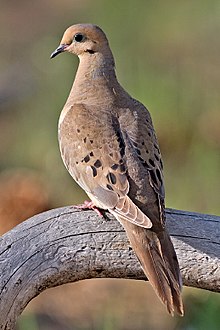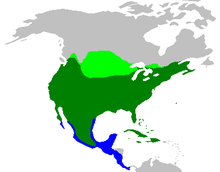Mourning dove
| Mourning Dove | |
|---|---|
 |
|
| Mourning Dove vocalizations | |
| Scientific classification | |
| Kingdom: | Animalia |
| Phylum: | Chordata |
| Class: | Aves |
| Order: | Columbiformes |
| Family: | Columbidae |
| Genus: | Zenaida |
| Species: | Z. macroura |
| Binomial name | |
|
Zenaida macroura (Linnaeus, 1758) |
|
| Subspecies | |
|
See text |
|
 |
|
| Summer only range Year-round range Winter only range | |
| Synonyms | |
|
|
See text
The mourning dove (Zenaida macroura) is a member of the dove family, Columbidae. The bird is also known as the American mourning dove or the rain dove, and erroneously as the turtle dove, and was once known as the Carolina pigeon or Carolina turtledove. It is one of the most abundant and widespread of all North American birds. It is also a leading gamebird, with more than 20 million birds (up to 70 million in some years) shot annually in the U.S., both for sport and for meat. Its ability to sustain its population under such pressure is due to its prolific breeding; in warm areas, one pair may raise up to six broods of two young each in a single year. The wings make an unusual whistling sound upon take-off and landing, a form of sonation. The bird is a strong flier, capable of speeds up to 88 km/h (55 mph).
Mourning doves are light grey and brown and generally muted in color. Males and females are similar in appearance. The species is generally monogamous, with two squabs (young) per brood. Both parents incubate and care for the young. Mourning doves eat almost exclusively seeds, but the young are fed crop milk by their parents.
The mourning dove is closely related to the eared dove (Zenaida auriculata) and the Socorro dove (Zenaida graysoni). Some authorities describe them as forming a superspecies and these three birds are sometimes classified in the separate genus Zenaidura, but the current classification has them as separate species in the genus Zenaida. In addition, the Socorro dove has at times been considered conspecific with the mourning dove, although several differences in behavior, call, and appearance justify separation as two different species. While the three species do form a subgroup of Zenaida, using a separate genus would interfere with the monophyly of Zenaida by making it paraphyletic.
There are five subspecies of mourning dove:
...
Wikipedia

